Month: November 2020
Developing Mortgage Apps: Types, Advantages, and Actionable Tips
Lending and mortgage apps market in 2020
Before diving into the specifics of developing mortgage and lending apps, let’s take a quick look at what the lending app market looks like in 2020.
According to Statista, in 2020, the value of transactions in the consumer lending market will reach $20,391.5 million.
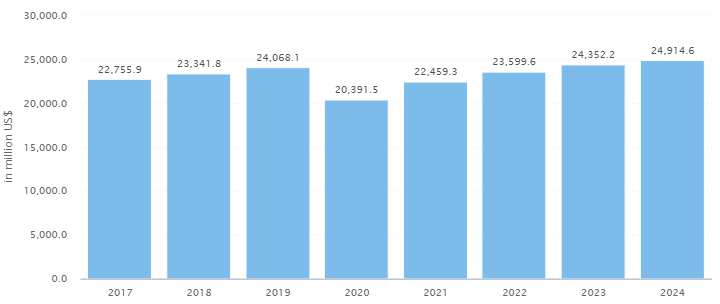
From the graph above, we can see that by 2024, this market is expected to grow to $24,914.6 million.
Now let’s consider what types of loan applications you can create.
Lending apps by type of loan
Loan applications differ in the types of loans they offer. Nowadays, people can take out loans for almost any situation:
- Mortgages (home loans)
- Buying a car
- Going to school
- Covering personal expenses
- Expanding a small business
Personal loans are the most versatile type in the consumer lending market. Users of lending apps can take out personal loans for all kinds of emergencies, from car and home repairs to new construction, covering gaps in daily expenses, and consolidating debt.
Lending apps by type of lender
Lending applications can also be differentiated by lenders. There are three types of organizations that provide loans through mobile and online applications:
- Banks and other traditional financial institutions
- Credit unions
- P2P lending platforms
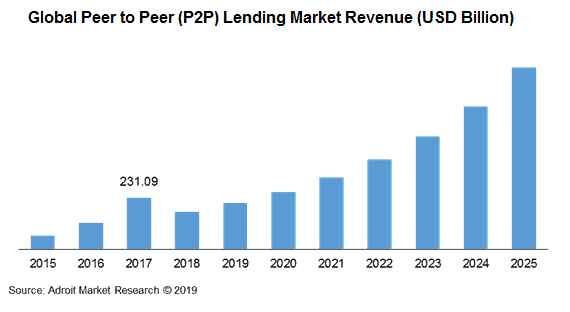
Banks and other financial institutions are adding mobile lending features to their mobile banking apps. But sadly, these features are often just a starting point, and consumers still need to visit a bank to get a loan. Credit unions are like banks, but a borrower needs to join the union and sometimes spend some time with the union before obtaining a loan.
Lending apps by technology stack
Lending apps are a big part of the FinTech revolution, which involves the digitization of financial relations. They make full use of the latest technology:
- Blockchains and smart contracts
- Big data
- Machine learning and artificial intelligence (AI)
- Chatbots
Blockchain technology supports loan applications by offering cryptocurrencies such as Bitcoin, Ether, and Litecoin to borrowers.
Big data combined with AI algorithms enables lenders to make informed decisions about the most appropriate interest rates and loan amounts.
Chatbots help take the burden off lenders’ front offices and personalize customer service.
Must-have features for a mortgage app
To build a loan app that users will love, you should take a close look at its feature set.
Here’s a list of basic features a lending app should have.
Registration
Let your users choose between three methods of registration. The first is to sign up via social media accounts like Facebook or Instagram. The second is standard registration using an email, name, and other contact details. The third is registration via phone number. The easier registration is, the more users will register in your app.
Note that you can get details later when users start applying for loans.
User profiles
In user profiles, users should be able to add personal information and edit details. User profiles in a lending app should let users display photos, names, and short descriptions.
Loan application form
The loan application form is the core of a lending application. Users will appreciate it if you divide the loan application process into discrete steps, guiding them throughout the process and showing progress.
Mortgage calculator
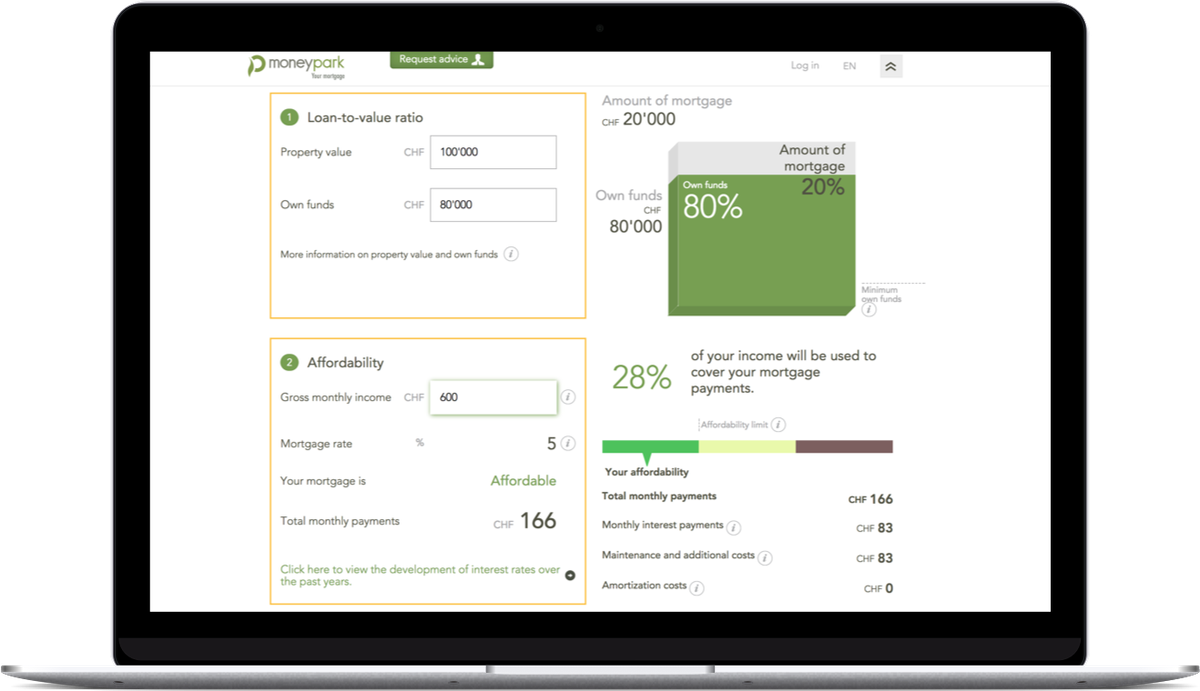
This feature helps mortgage applicants find out if they’re eligible for a mortgage they want to apply for. A mortgage calculator estimates an applicant’s credit rating based on basic job data and income. This is the first point of contact with your prospect. This step reduces the time it takes to make a lending decision and triggers automatic crashes in providing credit to unsuitable candidates.
Open banking integrations
Another valued feature is open banking integration. This is one of the technologies that underlies a mortgage calculator. Open banking operations provide access to customers’ financial data, including information on their taxes, monthly income, expenses, loans, bankruptcy filings, and so on from banks and other financial institutions. Open banking is a big part of making faster, more accurate, and more informed lending decisions.
KYC identity verification
To prevent fraud and combat money laundering, you need to integrate KYC (Know Your Customer) identity verification when creating a mortgage service. A KYC service checks an applicant’s credit history, confirms an applicant’s ID, and can even verify an applicant with facial biometrics. KYC services enable automated identitychecks and simplifies risk assessment.
Payments log
Once a loan has been financed, customers will need a place to view all outstanding and completed payments. They should also have information about the remaining debt. A payment gateway is one of the most important features of any online mortgage app. You can let users pay by PayPal, credit card, direct bank transfer, or cash on delivery.
Notifications
Use push notifications to improve user engagement and inform users about upcoming payments. You can even add logic so that customers are notified a couple of days before a payment is due and are notified if they miss a payment.
Live chat support
While lending apps do a great job of eliminating the need for personal contact with a banker, some of your clients are likely to ask for help anyway. Allowing them to communicate with your representatives can be a great way to deal with these situations.
Chatbot
When support representatives aren’t available, a chatbot can help users solve common problems and explain how your app works.
Geolocation
If your product allows users to withdraw cash from ATMs, you can use geolocation data to help them find the closest ATM.
Credit score
You can also integrate your app with a credit rating service. This feature will help clients better understand their loan eligibility.
Four steps to develop a mortgage app
Here are four steps to bring your mortgage app idea to life and simplify the development process.
1. Research your app’s target market
When developing a mortgage mobile app, the first thing you need to consider is your target audience. Understanding your users’ needs makes development easier and leads to a better final product. Find out as much as you can about your potential users. You can start by researching the following:
- Demographics. Find out the average age of your users, where they live, what devices they use, etc.
- Behavioral trends. Find out what decreases a user’s desire to download an app, your users’ security expectations, and so on.
To develop an amazing mobile application, we suggest creating a user persona, or a detailed portrait of your ideal user.
2. Choose a monetization model
The next step is to choose the right monetization model for your mobile application. Now that you know your users’ needs, you can predict what your users will pay for.
For example, intermediary companies that create peer-to-peer software receive revenue from fixed payments by borrowers or by taking a small percentage of the loan amount from both the borrower and the lender.
3. Hire an app development team
The third step is to find a development team you want to work with. The first phase of development will include conducting business analysis, developing a technical specification, estimating the development cost, and planning the project. Before diving into the actual development of your mortgage mobile app, you and your team should set up an app development workflow, choose the main features for the app, and design an app concept.
Then your development team should create project milestones and start working on the minimum viable product, or MVP.
4. Create an MVP
Creating a mortgage app is a big and complex project. We recommend launching a minimum viable product first and testing its technical and business performance. By using the MVP approach, you’ll be able to find out what users like and don’t like in your app. Then you’ll be able to consider their feedback and improve your app.
How much does it cost to build a mortgage app?
The cost of developing a mortgage mobile app depends on these factors:
- Product features
- Product design
- Hourly rate of your development team
- Project size and complexity
- Technology stack
- Number of team members on the project
- Time frame
Technologies that can increase the price include:
- Machine learning
- Cryptocurrency and smart contracts
- Big data integration
The biggest factor that influences a project’s cost is the hourly rate of developers, and that often depends on their location. For example, an application that costs $40,000 to build in the US will cost around $9,000 if developed by engineers in Ukraine.
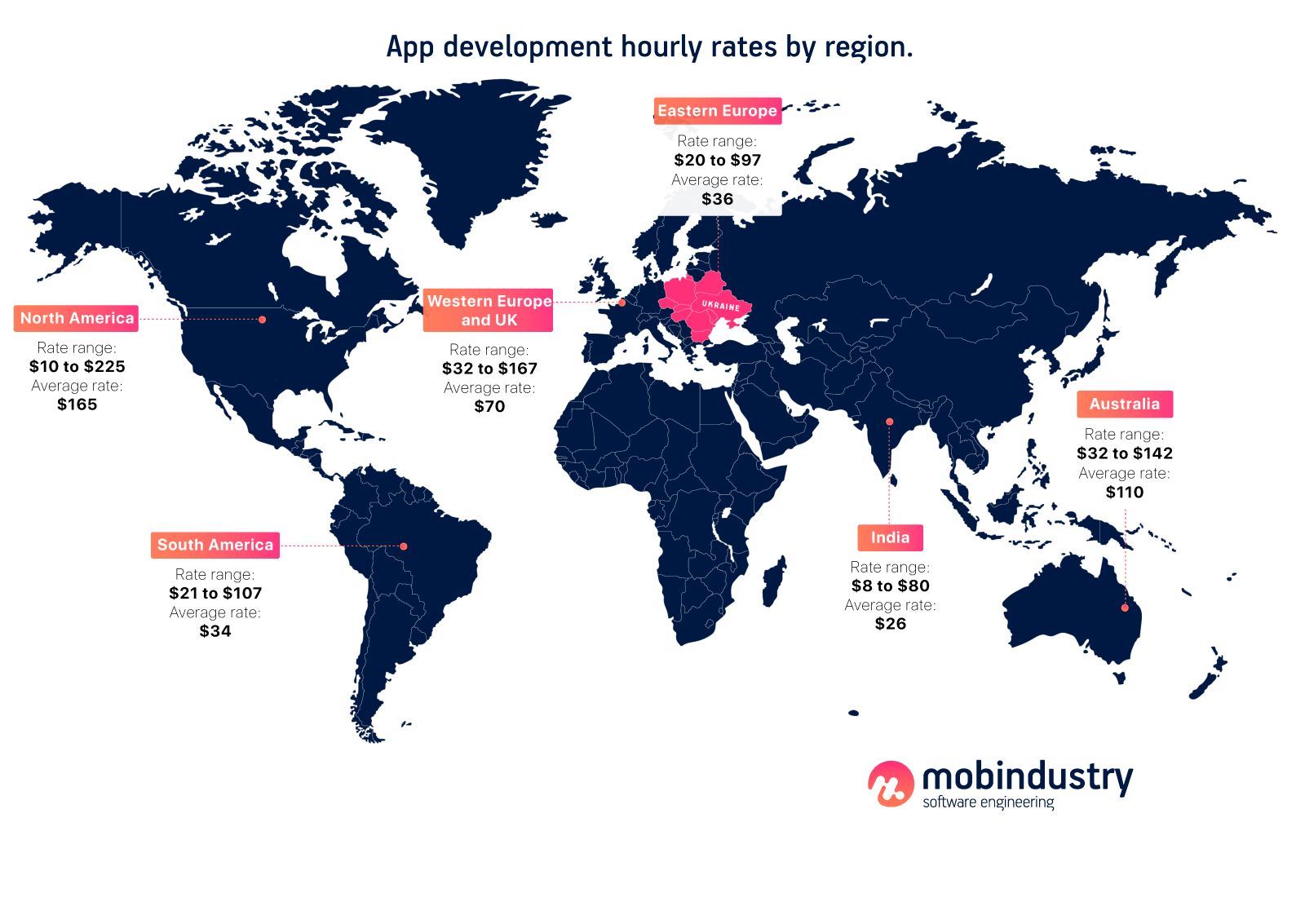
Developing your project with a company based in Eastern Europe is cost-effective and gives you access to top talent.
Important aspects to consider when developing a mortgage app
Find a good lawyer
For a different types of businesses, you may not need a lawyer. But when it comes to a lending business, you need an experienced lawyer who can handle all of your legal issues related to equity investments and explain how to proceed.
Hire a financial specialist
In addition to a lawyer, you’ll also need a financial specialist to write and review all of your policies and procedures and ensure they comply with financial regulations. Your financial specialist should be highly qualified and have extensive experience in the credit and banking sector. They can help you decrease risks associated with the mortgage process.
Draft a loan agreement
You should also consider drafting a loan agreement when establishing a mortgage startup. Users will need to familiarize themselves with all terms and conditions of a loan. In addition, a loan agreement must comply with financial regulations.
Find a bank partner
Choose a good bank for storing money from investors and borrowers. Working with a bank can help you resolve many issues with your new loan products, since a bank already has compliance procedures in place. Also, don’t think that you’re limited to just one bank. You can partner with multiple banks to get more benefits. But it will cost more.
Follow local and international laws
Remember that you need to comply with all applicable local and international laws when creating a product that targets customers beyond your local market. You’ll need to learn how to deal with all legal issues when developing a loan application. We’ll talk about this more later.
Consider multiple integrations
Usually, lending apps require third-party solutions, so your loan app should be prepared for integrating payment systems, eWallets, and banking providers.
Legal compliance and encryption
Fault tolerance must be ensured
A lending app must be fault-tolerant. This means it runs smoothly even under a heavy load due to a large number of concurrent operations. To ensure this, developers need to use a dedicated failover tool.
Security comes first
Your lending mobile app needs to be sufficiently secure, and you need to protect your software from the most common risks such as XSS (cross-site scripting), SQL injection, sensitive data disclosure, and authentication breaches. In order to encrypt all personal data of users and creditors, you’ll have to use modern encryption methods and signature technologies. Users must also have an encrypted authorization using PIN codes, passwords, and even biometric authentication methods.
GDPR compliance
If you’re creating a mobile app for the EU market, you need to bring your loan application in line with the General Data Protection Regulation (GDPR). The GDPR came into effect on May 25, 2018. Complying with the GDPR is a vital step that cannot be ignored.
CCPA compliance
The California Consumer Protection Act (CCPA) is a law you must follow if you create a mobile app for California residents. The main purpose of this law is to give users more control over their personal data. The CCPA came into effect on January 1, 2020. If you’re targeting California, you need to make your loan app CCPA compliant.
Be aware that laws and regulations vary depending on the region in which you plan to offer your mortgage application. If you’re building an app for the Asian, UK, Australian, or other markets, pay attention to the local regulations.
Examples of successful mortgage startups & platforms
Before developing a loan application, it’s worth taking the time to research your competitors. This will help you to learn from their mistakes and think about unique features that will set your application apart. Here are some good mortgage platform models to follow if you decide to create software for a mortgage service.
Molo

Molo is a mortgage service that was launched in 2016 and raised £3.7 million in capital during the first round of investment. Molo accelerates the decision-making process on mortgages and requires clients to supply minimum documentation. Here are some basic Molo features you should pay attention to when developing your own mortgage app:
- Molo’s mortgage calculator gives the user a rough estimatebased on the data they enter and internal calculations.
- An automatic consultation allows Molo to tailor each offer to the client’s needs.
- Appraisal functionality powered by artificial intelligence algorithms verifies the identity of a user using an ID photo or selfie and evaluates real estate.
- The Primary Offer tool matches a client’s credit score with available mortgages.
- A legal support mechanism ensures that each transaction complies with applicable laws and regulations.
MoneyPark

MoneyPark is a mortgage service that was launched in 2011 and acts as a broker between banks and clients, with a focus on mortgages and insurance. MoneyPark has a complex infrastructure and consists of the following parts:
- A website for checking the best mortgage deals, including a free online calculator
- A web-based platform for communicating with representatives and advisers of banks and conducting complex assessments
- A built-in CRM system that provides internal data processing and handling, and a B2B CRM system that connects MoneyPark with Finance Park partners
- Financial Park is a web-based platform for partners who want to provide similar services similar based on MoneyPark technologies.
- iOS and Android apps allow users to check general information, make appointments with consultants, and call or send messages to MoneyPark representatives.
Sindeo

Sindeo is a lending service that was launched in 2013. It helps clients find new mortgages and refinance existing ones at the same time. Its mobile-friendly consumer portal helps real estate agents issue loans to their clients. Sindeo allows users to fill out applications by providing comprehensive information about themselves. It also covers identity verification and confirmation of customers’ credit ratings.
Sindeo’s solution includes a number of integrations:
- Salesforce.com for attracting potential customers, tracking communication history, and seeing that potential and existing customers communicate with a specific representative
- Box.com for authorizing the upload of required documents to the portal
- Mortech to calculate quotes
- Yodlee and Finconnect for verifying customers’ personal information (e.g. employment, income, etc.)
- Mismo for online credit reports and other integrations to ensure the best user experience
Examples of the best loan apps
Prosper

Prosper, with headquarters in San Francisco, is a P2P lending platform that appeared on the market in 2005. The platform connects investors with borrowers and has already helped over a million people with $17 billion in loans. Prosper automatically recommends loans based on a borrower’s profile. The Prosper app works on Android and iOS.
Lendingclub

LendingClub is a San Francisco-based P2P lending web application that has been on the market since 2007. LendingClub focuses on four types of loans: personal, business, car refinancing, and medical. The company has served more than three million customers with over $50 billion in loans. The service has iOS and Android apps that allow investors to control their investment portfolios. Borrowers can use the mobile version of the company’s website.
Avant
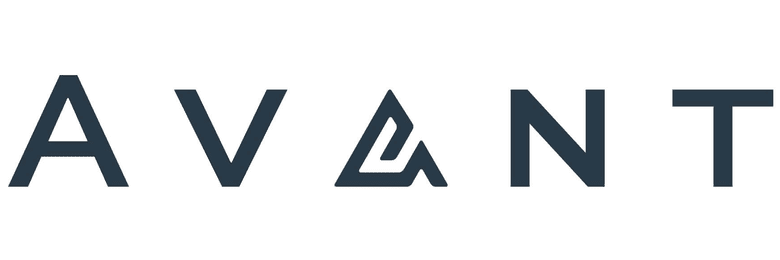
Avant has a mobile app for iOS and Android that borrowers can use to track their payment history, make payments, and receive notifications about account details. Avant also offers additional options such as a branded credit card.
Quick summary of developing a lending and mortgage app
If done correctly, a lending or mortgage app can become successful and bring a lot of value to users.
Key takeaways:
- According to Statista, in 2020, the value of transactions in the consumer lending market will reach $20,391.5 million.
- Personal loans are the most versatile type of loan in the consumer market.
- There are three types of organizations that provide loans through mobile and online applications: banks and other traditional financial institutions, credit unions, and P2P lending platforms.
- Lending apps are a big part of the FinTech revolution that involves the digitization of financial relations, and they make use of the latest technologies including the blockchain and smart contracts, big data, machine learning, AI, and chatbots.
- Creating a mortgage or lending app is a big and complex project. We recommend launching a minimum viable product first and testing its technical and business performance.
- If you’re creating a mobile app for the EU market, you need to bring your loan application in line with the GDPR. If you’re developing an app for Asia, the UK, Australia, or other regions, pay attention to local laws and regulations.
- Developing your project with a company based in Eastern Europe is cost-effective and gives you access to top talent.
- Your lending app needs to be sufficiently secure, and you need to protect your software from the most common risks such as XSS (cross-site scripting), SQL injection, sensitive data disclosure, and authentication breaches.
If you want to create a lending or mortgage app but don’t know where to start, contact Mobindustry for a free consultation.

